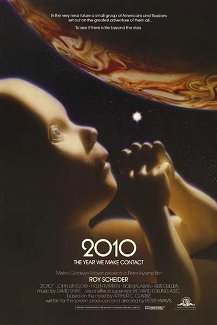Critical reception
Critical reception to 2010: The Year We Make Contact was mixed. [19] [20] On the review aggregator website Rotten Tomatoes , 68% of 37 critics' reviews are positive, with an average rating of 5.80/10.The website's consensus reads: "2010 struggles to escape from the shadow of its monolithic predecessor, but offers brainy adventure in a more straightforward voyage through the cosmos." [21] Metacritic , which uses a weighted average , assigned the film a score of 53 out of 100, based on 15 critics, indicating "mixed or average" reviews. [22] Critics generally considered the film inferior to 2001: A Space Odyssey, [23] : 14–15 and considered its story "too literal in laboriously explaining" the mysteries of the original film. [24] : 142 Syd Mead's designs for the film received critical acclaim. [25] : 64
Roger Ebert gave 2010: The Year We Make Contact three stars out of four, writing, "It doesn't match the poetry and the mystery of the original film, but it does continue the story, and it offers sound, pragmatic explanations for many of the strange and visionary things in 2001." He praised it as a "triumph of hardware, of special effects, of slick, exciting filmmaking". Ebert also wrote it "has an ending that is infuriating, not only in its simplicity, but in its inadequacy to fulfill the sense of anticipation, the sense of wonder we felt at the end of 2001". He concluded, however: "And yet the truth must be told: This is a good movie. Once we've drawn our lines, once we've made it absolutely clear that 2001 continues to stand absolutely alone as one of the greatest movies ever made, once we have freed 2010 of the comparisons with Kubrick's masterpiece, what we are left with is a good-looking, sharp-edged, entertaining, exciting space opera". [26]
Colin Greenland reviewed 2010 for Imagine , calling it "a tense space drama with excellent performances from Helen Mirren and John Lithgow, and glorious special effects. For everyone who was mystified by 2001." [27]
John Nubbin reviewed 2010 for Different Worlds magazine and stated that "It was a good, common denominator film. Despite its too happy ending, it is well-deserving of the praise it received, and little-deserving of any strong criticism. A good, solid picture, the kind we need a lot more of." [28]
James Berardinelli also gave the film three stars out of four, writing, "2010 continues 2001 without ruining it. The greatest danger faced by filmmakers helming a sequel is that a bad installment will in some way sour the experience of watching the previous movie. This does not happen here. Almost paradoxically, 2010 may be unnecessary, but it is nevertheless a worthwhile effort." [29] He wrote that the visual effects "are as good as, although not noticeably better than, those used in 2001". [29]
Reviewing the film for BBC, Almar Haflidason praised the film's cinematography and visual effects. He wrote, "by writing, producing and directing a follow-up to 2001, [Hyams] was really putting his head on the block if he screwed it up. Thankfully for him he didn't." Through narrative storytelling, Haflidason describes the film as a chance for Clarke and Hyams to explain what 2001 was about. The review praises Hyams's narrative-based handling of the tension between the Soviet and American teams, and says that his "skills as a cinematographer are evident with fine visual effects throughout." [30]
A review in Time Out describes a film that, while not as revolutionary as its predecessor, "is still a better film than anyone could have dared to expect," and describing it as "space fiction of a superior kind". [31]
Other critics had more negative opinions. Vincent Canby of The New York Times gave 2010: The Year We Make Contact a lukewarm review, calling it "a perfectly adequate though not really comparable sequel" that "is without wit, which is not to say that it is witless. A lot of care has gone into it, but it has no satirical substructure to match that of the Kubrick film, and which was eventually responsible for that film's continuing popularity." [32]
Variety considered the film a mess, although not without bright spots. "In Peter Hyams' hands [working from a novel by Arthur C. Clarke], the HAL mystery is the most satisfying substance of the film and handled the best. Unfortunately, it lies amid a hodge-podge of bits and pieces." [33] TIME was dismissive, writing, "Flash: There is intelligent life in outer space. More, anyway, than in this amiable footnote of a movie." [34]
